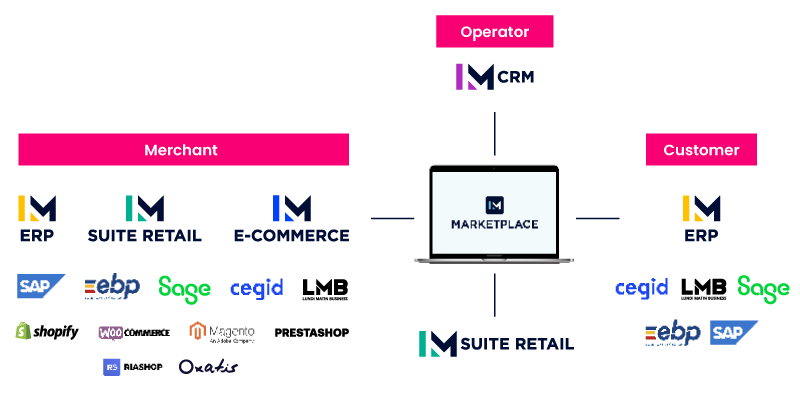The landscape of modern commerce has undergone a profound transformation over the last two decades. It evolves from simple e-commerce to omnichannel and finally welcoming the emergence of marketplaces. These platforms have grown in popularity by offering a more dynamic model, responding to the ever-changing needs of consumers.
Today, we are at the heart of a new evolution in commerce with the Omnichannel Marketplace. It’s a convergence of physical and digital sales channels. It not only redefines the customer experience, but also paves the way for new commercial opportunities.
The temporal evolution of modern commerce
The 2000s saw the emergence of e-commerce, captivating consumers with the promise of unprecedented simplicity and speed in their purchases. It was a time when clicks replaced steps, and the traditional boundaries of shopping began to blur.
However, between 2005 and 2010, a new era took shape – that of omnichannel. During this period, the digital and physical worlds gradually merged. Companies understood the crucial importance of offering a seamless customer experience across all channels. It creates a seamless link between online interaction on an e-commerce site and in-store experiences.
Over the next decade, from 2010 to 2023, the spotlight shifted to marketplaces. These virtual spaces have taken commerce by storm, offering a robust business model for third-party sellers. Abundant choice, easy price comparisons and secure transactions took centre stage, setting a new standard in the contemporary shopping landscape.
Today: the Omnichannel Marketplace
Today, we are entering a new era with the Omnichannel Marketplace.
This approach goes far beyond traditional boundaries, creating a new customer experience by establishing a seamless web between the physical and digital worlds.
This transition marks a significant turning point in the way businesses interact with their customers. It offers a seamless continuity between online and in-store experiences. The Omnichannel Marketplace is becoming the catalyst for a major transformation in the retail landscape, redefining the very nature of shopping and paving the way for a new era of opportunity and innovation.

What is the Omnichannel Marketplace?
An omnichannel marketplace is an e-commerce platform that seamlessly integrates physical and digital sales channels to offer consumers a seamless shopping experience. Unlike a traditional marketplace, which focuses primarily on online transactions, the omnichannel marketplace broadens its scope to include in-store interactions.
This omnichannel approach aims to create a seamless continuity between online and in-store shopping experiences, allowing consumers to use a variety of interchangeable channels such as websites, mobile applications, physical points of sale, and other digital channels. The seamless integration of different channels allows customers maximum flexibility in their shopping experience, while providing sales staff with increased visibility and unified management of business processes.
The key to success: customer service and innovation
The triumph of the Omnichannel Marketplace is undoubtedly based on the quality of its customer service and its ongoing commitment to innovation.
Customer satisfaction, the cornerstone of this success, depends on impeccable customer service management, seamless integration of the Information System in the B2B context, constant updating of information, and a dynamic of perpetual innovation in the purchasing process. The example of Station One, with Alstom, illustrates this perfectly through the constant updating of product and supplier information, as well as an evolving purchasing path for each customer.
Benefits for sellers and buyers
The Omnichannel Marketplace offers a number of advantages that benefit both sellers and buyers.
Advantages for buyers
- Purchasing flexibility: Buyers enjoy the freedom to choose between buying online and in-store, depending on their personal preferences, availability or the urgency of their needs.
- Greater product visibility: Consumers have access to a wider range of products both online and in-store.
- Consistent customer experience: Shoppers can expect a consistent experience, whether online or in-store, in terms of customer service, returns policy and other aspects, building trust.
- Ease of price comparison: The ability to quickly compare prices across different channels allows shoppers to find the best deals, promoting healthy competition between sellers.
Benefits for sellers
- Easier expansion: Sellers have the opportunity to reach a wider audience by leveraging both online and physical channels, which can lead to significant geographic expansion and growth.
- Lower barriers to entry: An Omnichannel Marketplace can reduce initial costs and barriers to entry for smaller sellers, making it easier for them to enter the market.
- Adaptability to consumer trends: By observing buying behaviour across different channels, sellers can quickly adjust their inventory and offering to keep pace with emerging trends.
- Brand reinforcement: Consumers can interact with the brand in a variety of ways, reinforcing loyalty.
These benefits help to create a dynamic commercial ecosystem, where both buyers and sellers find significant added value.
The success story of an Omnichannel Marketplace
Viability of the business model
The success of an omnichannel marketplace depends essentially on the soundness of its business model. To make an omnichannel marketplace economically viable, it is essential to consider several aspects, from strategic planning to operational implementation. Here are a few tips to ensure the economic viability of an omnichannel marketplace:
- In-depth market analysis: Understand market trends, consumer buying behaviour and emerging opportunities. Identify the market segments that can benefit most from the omnichannel approach to integrating merchants and their products into your catalogue.
- Channel integration: Ensure seamless integration between online and physical channels for each merchant. Information on stocks, prices and promotions must be consistent across all customer touch points.
- Optimal customer experience: Focus on the customer experience. Make it easy to navigate, set up loyalty programmes and provide effective customer support online and in person.
- Marketing strategies: Develop consistent marketing strategies across all channels. Use the data collected to personalise promotions and offers, boosting engagement and sales.
Business opportunities in the marketplace
The Omnichannel Marketplace opens the way to a range of commercial opportunities. Revenue growth is at the forefront, supported by a significant increase in in-store and online traffic.
This approach gives participating merchants greater visibility and brand awareness, strengthening their market position.
Optimising inventory and logistics is an additional opportunity, ensuring efficient management of operations, and takes on particular importance in the context of an omnichannel marketplace due to the convergence of online and physical channels. Here are a few points specific to the omnichannel marketplace:
- Centralised inventory management: An omnichannel marketplace integrates online and in-store inventory, enabling centralised management. This provides real-time visibility of stock levels across all channels, facilitating efficient management and avoiding channel mismatches.
- Click and Collect: Optimising stock levels makes it easier to implement ‘click and collect’. Customers can order online and collect their products in-store, offering a convenient option while minimising shipping costs.
- Flexibility in order management: Integrated stock management means that orders can be managed more flexibly. For example, online orders can be dispatched from a central warehouse or from a physical shop, depending on stock availability.
- Customised product offering: In-depth understanding of stock levels across all channels enables greater personalisation of the product offering. Promotions and recommendations can be adjusted according to actual product availability.
- Optimisation of collection points: For in-store collection options, optimised stock management can help determine which shops have products available for collection.
- Reduce shipping costs: Using an omnichannel and proximity approach, the marketplace can leverage the proximity of in-store inventory to reduce shipping costs, for example by favouring shipping from shops closest to customers’ destinations.
- Adapt to fluctuations in demand: The omnichannel marketplace can quickly adjust stock levels in line with variations in demand across different channels. This avoids overstocking or stock-outs, improving agility in the face of market fluctuations.
Strategic partnerships, the exploration of new markets and the diversification of offerings are all facets which, when combined, form fertile ground for the growth and success of the marketplace.
How can omnichannel be introduced into the heart of the marketplace?

1. Omnichannel: Marketplace + Merchant ERP
The operational efficiency of the Omnichannel Marketplace depends on the seamless integration of processes, particularly with the Merchant ERP. In this model, the interconnection between the Marketplace and the merchant ERP system becomes crucial.
This symbiosis ensures efficient management of catalogue flows, product stock quantities, customer orders, logistics and even invoicing processes for the Merchant.
2. Omnichannel: Marketplace + ERP B2B Customer
In this configuration, the integration between the Marketplace and the B2B customer’s ERP system offers concrete benefits, mainly by providing transparent visibility of supplier order tracking. Thanks to this collaboration, B2B customers can transparently track the status of their orders, improving supply management in a more informed and responsive way.
This integration also facilitates efficient logistics management, ensuring seamless coordination of logistics processes between the Marketplace and the B2B customer’s ERP system, contributing to an optimal B2B buying experience.
3. Omnichannel: Marketplace + CRM
Integration with a Customer Relationship Management (CRM) system improves the management of commercial relationships between the operator and merchants. For the operator, this makes it easier to prospect for potential merchants, monitor sales opportunities and convert/onboard new merchants.
By optimising interactions with merchants, the Omnichannel Marketplace strengthens its position as a collaborative platform. It fosters long-lasting and fruitful commercial relationships. Integrating CRM with the Omnichannel Marketplace enables the operator to strategically manage relationships. It also enables to gain an in-depth understanding of the merchant lifecycle, enabling informed decision-making to ensure the continued growth of the platform.
4. Omnichannel: Marketplace + Checkout
This combination considerably broadens the product range. Not only does it provide access to the entire Marketplace catalogue, including items that would not be physically present in shop.
Integration with the checkout introduces the possibility of ordering online and collecting items directly from the shop, and vice versa. In this way, even products that are not immediately available in-store become accessible, considerably widening the choice for consumers.
In addition to extending the catalogue, this combination enables the implementation of specific loyalty programmes. Customers can benefit from exclusive offers, targeted promotions and a more personalised shopping experience.
The impact of the Omnichannel Marketplace on the customer experience and business management
The transition to the Omnichannel Marketplace is creating a significant transformation in the customer experience, offering seamless connectivity between online and in-store channels. This seamless integration aims to eliminate barriers, creating a seamless experience for consumers.
Consumers can navigate seamlessly, offering a dynamic and adaptive digital experience. This versatility meets consumers’ high expectations in terms of personalisation and diversity of online interaction. By offering a consistent and flexible experience, the Omnichannel Marketplace creates a deeper connection with consumers, reinforcing a company’s brand image.
This extended interconnection between digital and physical channels also has a positive impact on business management. By eliminating the silos between online and in-store operations, companies can optimise their internal processes, boosting efficiency and decision-making.
Make the omnichannel choice to transform your business
The Omnichannel Marketplace represents much more than a simple strategic decision: it’s a profound transformation of the commercial approach. Operators benefit from enhanced visibility and user-friendly management, while merchants benefit from channel diversification and greater flexibility. For B2B customers, the integration of their ERP and the personalised experience are undeniable advantages.
Thanks to omnichannel, each player in the sales chain creates a dynamic ecosystem where the customer experience is optimised and opportunities for growth are multiplied. LUNDI MATIN has positioned itself as the trusted partner for this transition, offering solutions that unleash the full potential of omnichannel commerce. Ultimately, choosing omnichannel goes beyond modernisation; it’s an opportunity to adapt, thrive and stay in step with evolving consumer expectations. Make omnichannel your competitive advantage with LUNDI MATIN.
To find out more about our omnichannel suite, contact us today
Our experts are here to support you in your digital transformation and help you grow your business.

